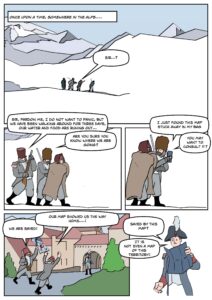

Many problems of life are ill-structured (e.g., humanitarian or military operations). That is, they are complex and rife with uncertainty, is it possible to make ‘good’ or ‘right’ decisions? Perhaps, in these complex situations success may depend on making the decision right (or making the decision work), rather than on making the normatively right decision.
In complex situations, the problem may be more analogous to adaptive control (i.e., making continual adjustments to incrementally satisfy the functional goals –muddling through), than the problem of discretely choosing a right option from a fixed set of alternatives. The loose coupling between a ‘right’ choice and a successful adaptation was illustrated by Karl Weick (1995) using the following story illustrated in the cartoon:
The young lieutenant of a small Hungarian detachment in the Alps sent a reconnaissance unit into the icy wilderness. It began to snow immediately, snowed for 2 days, and the unit did not return. The lieutenant suffered, fearing that he had dispatched his own people to death. But on the third day the unit came back. Where had they been? How had they made their way? Yes, they said, we considered ourselves lost and waited for the end. And then one of us found a map in his pocket. That calmed us down. We pitched camp, lasted out the snowstorm and then with the map we discovered our bearings. And here we are. The lieutenant borrowed this remarkable map and had a good look at it. He discovered to his astonishment that it was not a map of the Alps, but a map of the Pyrenees.
Weick concludes that this story suggests the possibility that “when you are lost, any map will do.” He continues:
The soldiers were able to produce a good outcome from a bad map because they were active, they had a purpose (get back to camp), and they had an image of where they were and where they were going. They kept moving, they kept noticing cues, and they kept updating their sense of where they were. As a result, an imperfect map proved to be good enough. The cues they extracted and kept acting on were acts of faith amid indeterminacy that set sensemaking in motion. Once set in motion, sensemaking tends to confirm the faith through its effects on actions that make material what previously had been merely envisioned [sic]. (p. 55)
Charles Lindblom (1959), in his classic paper “The Science of ‘Muddling Through,’” comes to a conclusion similar to Weick's. Lindblom noted that for complex policy decisions, the comprehensive evaluations that are suggested by normative models of decision-making are typically impossible:
Although such an approach can be described, it cannot be practiced except for relatively simple problems and even then only in a somewhat modified form. It assumes intellectual capacities and sources of information that men simply do not possess, and it is even more absurd as an approach to policy when the time and money that can be allocated to a policy problem is limited, as is always the case. (p. 79)
Lindblom offered a more heuristic program of incremental adjustment as a more realistic alternative to the classical, normative approaches to policy making. He called this heuristic, trial and error process: ‘muddling through.’
Twenty-years after his classic paper Lindblom (1979) comments:
Perhaps at this stage in the study and practice of policy making the most common view … is that indeed no more than small or incremental steps – no more than muddling – is ordinarily possible. But most people, including many policy makers, want to separate the ‘ought’ from the ‘is.’ They think we should try to do better. So do I. What remains as an issue, then? It can be clearly put. Many critics of incrementalism believe that doing better usually means turning away from incrementalism. Incrementalists believe that for complex problem solving it usually means practicing incrementalism more skillfully and turning away from it only rarely.
The question in the title of this post is actually a trick question. It is not a matter of better maps OR better muddling. We will always need both. Yes, the quality of decision making can be improved by utilizing the computational power of AI/ML algorithms to produce better decision aids (e.g., maps). But despite the increasing capacity of these information technologies, significant uncertainty will remain due to the nature of complexity and the difficulty in quantifying all the variables that might be important. Thus, success will ultimately depend to some extent on the skilled muddling of humans. As we begin to integrate AI/ML decision aids into our organizations, it is important to keep in mind that ultimately success will depend on the quality of the Joint Cognitive System - that includes smart technologies and smart people.
References:
Weick, K.E. (1995). Sensemaking in organizations. Thousand Oaks, CA: Sage Publications.
Lindblom, C.E. (1959). The Science of ‘Muddling Through.’ Public Administration Review, 19, 2, 79-88.
Lindblom, C.E. (1979). Still Muddling, Not Yet Through. Public Administration Review, 39, 6, 517-526.
